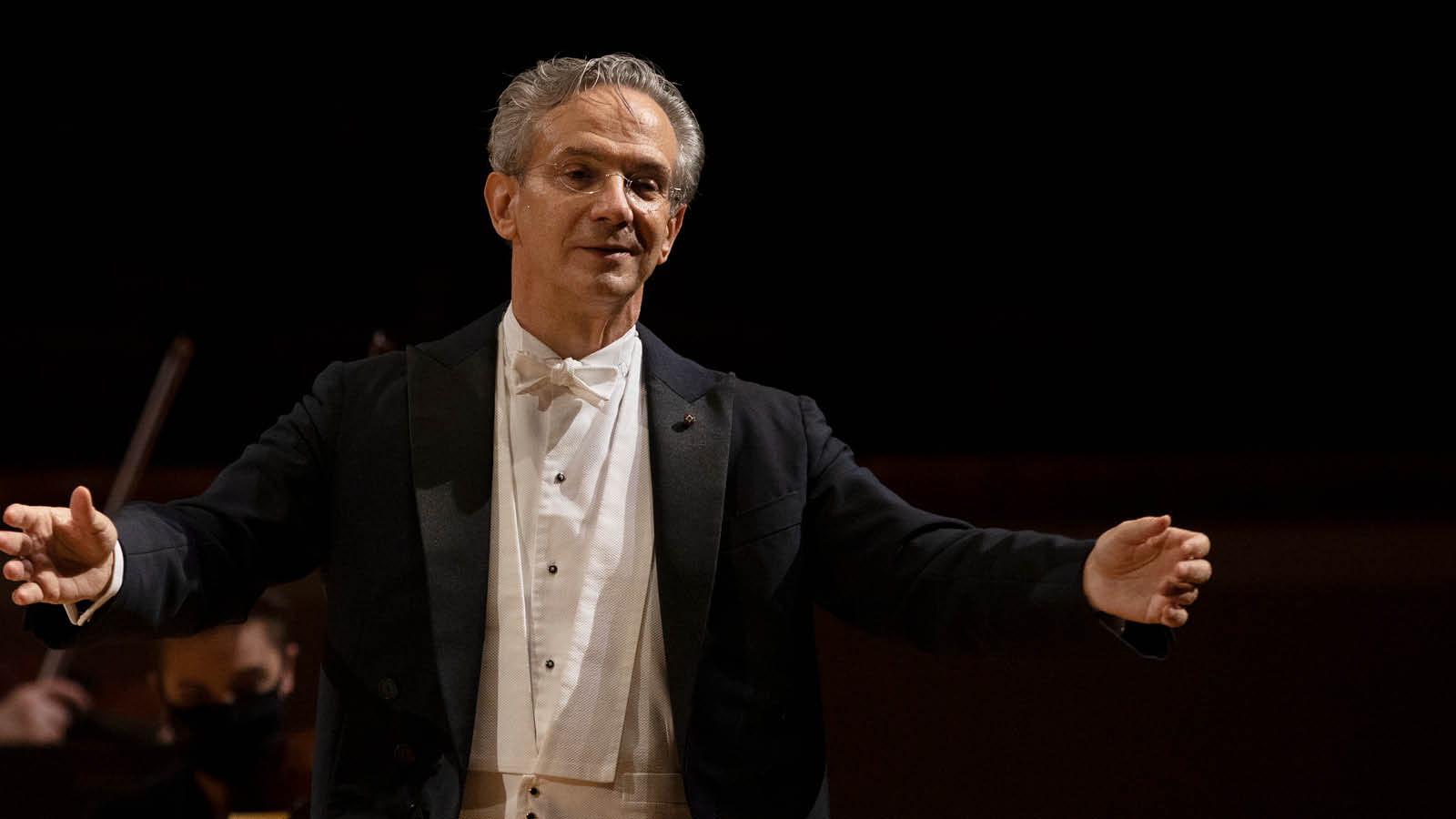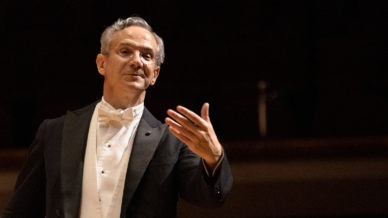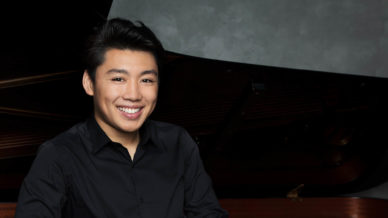

Brahms Symphony No. 3
March 16 – 18, 2023
FABIO LUISI conducts
MATTHIAS GOERNE baritone
MAHLER Selections of Twelve Songs from Des Knaben Wunderhorn
BRAHMS Symphony No. 3
Although Brahms was just 50 when he wrote his Third Symphony, he looked back to younger days with the musical quotation of the motto Frei aber froh (“Free but happy”). In the rising exclamation from the winds that open this great symphony, the F-A-F motif hits you immediately. The compactness of the work intensifies the dramatic aspects of his third and penultimate symphony. As you listen to this richly romantic piece, you get a real sense that Brahms had hit his stride as a composer.
NOTE: The DSO will record this weekend’s performances of Brahms Symphony No. 3 for a future album release.

Join us after the concert on Saturday for Meet the Musicians! You’ll have a chance to speak with Dallas Symphony musicians in a casual happy hour setting and learn more about members of the orchestra.
MORTON H. MEYERSON SYMPHONY CENTER
2301 Flora St.
Dallas, TX 75201

Program Notes
By René Spencer Saller
Mahler accepted his first paid conducting gig when he was only 20, presiding over third-rate operettas at a spa in Upper Austria. From then on, the ambitious and cash-strapped composer spent his entire life as a professional conductor, holding posts in Ljubljana, Kassel, Prague, Leipzig, Budapest, Hamburg, Vienna, and, at the end of his life, New York City. From the podium, he demanded much from each musician but gave even more, responding to the orchestra with an electric empathy and an intense physicality. Widely considered among the greatest conductors in the world, he applied his galvanizing intelligence to other composers’ scores, reinvigorating the repertoire and setting the interpretive bar impossibly high for future generations of professional maestros.
By 1888, when he began his Second Symphony, he was, if not as famous as he would someday become, widely well-regarded—as a conductor. As a composer, however, he felt misunderstood and undervalued, the eternal underdog. He wasn’t wrong. The disastrous premiere of his First Symphony in late 1889 hit him hard. Because of certain ugly socio-political and cultural realities—most obviously, an antisemitism so pervasive that it’s only remarkable in its occasional absence—Mahler’s career would be rocky, never mind his formidable talent and drive and his voluntary conversion to Catholicism.
After receiving a terminal diagnosis of heart disease in 1907, Mahler resolved to compose as much music as possible, of the highest possible quality, culminating in a flurry of late-life masterpieces, including Das Lied von der Erde, Symphony No. 9, and the unfinished Tenth. And despite being fired regularly for factors unrelated to his job performance, he kept conducting, leading the New York Philharmonic in the last two years of his life. He died at age 50, from complications of the heart condition that had been diagnosed four years earlier.
Wondrous Wunderhorn
In Mahler’s distinctive sound world, song and symphony are closely intertwined, even interdependent. His first four symphonies are called his Wunderhorn symphonies because they incorporate so many of his settings of texts from Des Knaben Wunderhorn (The Youth’s Magic Horn). This fanciful collection of German folk poetry, originally published between 1805 and 1808, was praised by literary luminaries like Goethe, who wrote of his hope that “this little book would find a place in every house where bright and vital people make their home…. Best of all, [that] this volume might lie on the piano of the amateur or master of musical composition so that these songs might come into their own by being matched to familiar and traditional melodies, that they might have appropriate tunes fitted to them, or that, God willing, they will inspire new and significant melodies.”
Eventually consisting of three volumes and a thousand or so poems, the Wunderhorn collection did indeed inspire a generation or two of Romantic composers and their successors. Among many others, Mendelssohn, Schumann, Brahms, Richard Strauss, and Schoenberg all wrote settings of these provocative and often grotesque fairy-tale poems, which touch on everything from famine to frivolous flirtation; from doomed drummers to fish prophets; from the magical riverine journey of a mower’s golden ring to the brutal execution of a child. The tales are spooky and preachy, pious and violent, funny and profound. For years they ignited Mahler’s imagination like nothing else.
Between 1887 and 1902, the year of his momentous marriage to Alma Schindler and the completion of his Fifth Symphony, Mahler set more than a dozen poems from the Wunderhorn collection for voice and piano or orchestra, and a half-dozen or so of these story-songs surfaced in the first five symphonies. In 1899 he published 12 of the Wunderhorn songs in the collection titled Humoresken (Humoresques)—informally, and confusingly, also known as Mahler’s “Songs from Des Knaben Wunderhorn.” Although Mahler had originally conceived these songs for voice and orchestra, he was shrewd enough to create alternative arrangements for voice and piano, tailored to the growing sheet-music market for amateur musicians.
Not all of the poems in the Wunderhorn collection are actual folk relics; some appear to be imitations or homages. The two editors, Achim von Arnim and Clemens Brentano, could also be described as authors—not so much disciplined collectors and compilers as resourceful recyclers and fabulists. The authenticity of any given tale mattered less to them than its entertainment value, and if they needed to invent certain details in the service of a greater truth, so be it. At any rate, Mahler, who was almost as sensitive to poetry as he was to music, took additional liberties with his source material, adding lines and verses as he saw fit. In fact, he wrote his own text for the 1892 song “Das himmlische Leben” (The Heavenly Life), which also served as the penultimate movement of his Fourth Symphony.
In addition to “Das himmlische Leben,” five other Wunderhorn songs functioned as pivotal movements in Mahler’s symphonies, including two featured in this concert: “Des Antonius von Padua Fischpredigt” and “Urlicht,” which did double duty in his Second Symphony as the Scherzo and fourth movement, respectively. Nicknamed the “Resurrection” Symphony, Mahler’s Symphony No. 2 in C Minor deals with death and rebirth, in the Christian tradition.
Born into a large and poor Jewish family, Mahler was still technically Jewish at the time of its composition. His interest in the spiritual aspects of Christianity predated his official conversion to Catholicism, in 1897, when he was 37 years old. Part of the reason he needed to make his faith a matter of public record was pragmatism, or self-preservation: the ever-worsening antisemitism of late 19th-century Austria made it impossible for a Jewish man, even an eminently qualified one, to land the desirable conducting posts, especially in Vienna, where Richard Wagner’s widow Cosima, the illegitimate daughter of Franz Liszt and a vicious antisemite, still exerted enormous influence.
A Closer Listen
1. “Rheinlegendchen” (Little Rhine Legend). Set in G major, with a 3/8 meter reminiscent of a Ländler, the richly evocative “Rheinlegenchen” is lightly scored—just a wind quintet with strings. It was so popular at its first performance that the audience demanded an immediate encore. The lyrics are sung from the perspective of a lovelorn young mower, who imagines what might happen to a ring tossed into the Rhine. The ring eventually ends up in the belly of a fish served at the King’s table, at which point, the mower predicts, the absent sweetheart will be unable to resist returning the ring—and returning the mower’s love. Throughout the song, Mahler sprinkles folk-inflected, improvisational-sounding riffs and licks, imparting a rollicking, rural flavor to the “little Rhine legend.”
The world premiere of the song took place at the Hamburg Konzerthaus, in October 1893, sung by Paul Bulss and performed by the Julius Laubesche Kapelle under Mahler’s own baton.
2. Composed in the summer of 1898 and published the following year, “Wo die schönen Trompete blasen (Where the Splendid Trumpets Sound), in C minor, is a strangely subdued song in which the singer assumes two roles: an ardent young woman and the soldier she loves, who may be a ghost—or, if not yet a ghost, a future ghost. Mahler contrasts the swooning, almost hallucinatory waltz of the lovers’ union with the doomy, inexorable 2/4 beat of the marching army, with its “splendid trumpets,” which are typically and unexpectedly soft when not actually muted. The song was first performed, along with “Das irdische Leben,” on January 14, 1900, sung by soprano Selma Kurz, with Mahler conducting the Vienna Philharmonic.
3. Completed in 1892 and first performed that December, in Berlin, “Verlor’ne Müh” (Wasted Effort) is another he-said-she-said dialogue song, with the singer again performing both male and female roles. Mahler deploys a lilting, Ländler-like 3/8 rhythm, along with sassy interjections and imitations. The comical lyrics are in the Swabian dialect (related to Alsatian and other Swiss-adjacent forms of German) and dramatize a persistent village maiden’s failed seduction of a young man, who not only rejects her offerings of “tender morsels,” “nibbles,” and “my heart,” but persists in insulting her, with increasing harshness, as a “foolish girl.” Her beloved, an obstinate and unloving prig, might get the last word, but the maiden gets the last laugh. (It’s safe to say that most of us, including the long-dead Mahler, would greatly prefer a leisurely meal with this agreeable, lamb-tending creature than another negging session with Buzzkill Boy.)
4. Mahler composed “Das irdische Leben” (The Earthly Life) sometime after early spring 1892. He shortened the source poem, originally titled “Verspätung” (Delay), but retained the haunting poignancy that befits a song about a child who begs his mother for bread until he starves to death: “And when at last the bread was baked/The child lay dead upon the bier.” Divided—and typically muted—strings convey the bereaved parent’s torment, that churning grief and choking helplessness. Early on, Mahler conceived of his Fourth Symphony (1899–1901) as a six-movement work that would also feature “Das irdische Leben” (The Earthly Life). This gritty ballad, a kind of proto-Kindertotenlied, serves as a dramatic counterpart to the celestial joy and abundance of “Das himmlische Leben” (The Heavenly Life), the spiritual climax of the Fourth Symphony.
5. Set in the remote key of D-flat major, “Urlicht” (Primal Light) functions in the Second Symphony as a transition, or a kind of introduction, to the finale. Mahler composed it in 1892 and orchestrated it the next year. His tempo indication is “Sehr feierlich, aber schlicht” (Very solemn, but simple). Originally written for mezzo-soprano or contralto, the singer’s radiant innocence transforms a simple declaration of faith into a passionate rhapsody. Listen to the winds curling around the singer’s voice; they seem to complete his thoughts, much as birdsong bends the night sky toward morning:
I am from God, I want to return to God.
The loving God will grant me a little light,
Will light my way to blissful life eternal and bright.”
6. Mahler repurposed “Des Antonius von Padua Fischpredigt” (Saint Anthony’s Sermon to the Fish,” in C minor, as the third-movement scherzo of his Second Symphony. Composed in summer 1893 and set in a dreamy 3/8, the song is marked “In ruhiger fließender Bewegung,” which in English means “In quietly flowing motion,” a fair description of its sound, if not its ironic humor. A magically twisty clarinet melody slips through skittery cross-currents of pizzicato and bowed strings as the singer describes the aquatic audience’s rapt attention to Saint Anthony. Like any good joke that lands, the song builds suspense through repetition, concluding with this devastating punchline on misplaced piety:
The crabs still go backwards,
The cod are still bloated,
The carp are still gorging,
The sermon’s forgotten.
The sermon was pleasing.
All stay as they were.
7. The intense and jarring “Revelge” (Reveille), also in C minor, depicts a death march: rattle-trap drums and strident trumpets, stomping feet and rotting corpses. The soldiers might as well be zombies, grimly enacting their pointless rituals at every predawn reveille, compulsively charging and slaughtering. The speaker is an army drummer, an adolescent, in fact, who has been wounded in battle and is now being left for dead, even trod on, by his marching comrades. The young drummer’s lament is all the more heartbreaking for its growing self-awareness:
“I will well play my drum
or else I will lose myself completely.
The brothers, plentiful sowed
tralali, tralalei, tralalera,
they lie as if they’ve been mowed.”
A revenant, he returns to his darling’s home, not yet aware that he’s dead. (Listen for the col legno strings, meant to mimic the grinding, scraping sound of bone on bone.) That morning, in a ghoulish twist, the drummer’s bones and those of his comrades appear arranged “in rank and file, like tombstones” at her front door, with the drum out in front “so that she can see him.” Mahler composed this song in July 1899.
8. Composed in summer 1901, around the time that he was beginning his Fifth Symphony, “Der Tambourg’sell” (The Drummer Boy) was the last of Mahler’s Wunderhorn settings—and wouldn’t you know it, it’s another song in C minor from the perspective of a doomed young drummer. This time the singer and first-person narrator is in prison, not underfoot on a bloody battleground, but he’s dying all the same: marched from his cell to the gallows. Never mind that he’s still a child—too young to fight, but old enough to be killed. The music, a protracted funeral march, is somber, even sepulchral.
As with “Revelge,” Mahler conjures up all manner of spooky effects from col legno strings. In an elegiac address to everything he can see on his march to the scaffold, the singer ticks off a series of farewells, repetitively, almost self-soothingly—think Margaret Wise Brown’s Goodnight Moon, only infinitely sadder—before closing with a pair of final, heartbreakingly understated “Gute Nacht”s. Mahler’s indications call for the first “good night” to start loud, then go suddenly quiet; the second is supposed to be sung “mit brechender Stimme” (with broken voice).
If all this sounds a bit morbid, it might help to remember that Mahler had almost died that February, when he woke in bed to find the sheets soaked in blood from a hemorrhage. He would marry the next year, but he would die within the decade, after suffering the grievous loss of his eldest daughter, Maria, who succumbed to scarlet fever.
In May 1883, Brahms turned 50. Richard Wagner, his esteemed adversary, had died a few months earlier; Clara Schumann, his intimate friend, cheerleader, and steadfast muse, was nearly 64 and quite frail; he had already outlived many friends and musical mentors. Yet he was robustly healthy, if somewhat fat, and had a lust for life—as well as for young women. That summer he followed one of them, the contralto Hermine Spies, to Wiesbaden, on the Rhine. There he composed his Symphony No. 3. It had been six years since his previous symphony, another product of a single fertile summer.
Although he continued to tweak the score until its publication, the Third was a triumph from the start. After he sent the score to Clara, she gushed, “From start to finish one is wrapped about with the mysterious charm of the woods and forests…. [By the finale] one’s beating heart is soon calmed down again for the final transfiguration which begins with such beauty in the development that words fail me!”
Except for the predictable demonstration from the Wagner Club, whose members briefly disrupted the Vienna premiere, Brahms’s Symphony No. 3 was hailed as a masterpiece by audiences and critics alike.
A Closer Listen
The shortest of Brahms’s four symphonies, the Third is formally rigorous and tonally inventive, thematically integrated and rhythmically complex. Unusually, all four movements end softly, even the seemingly heroic finale. The first movement begins with two audacious wind chords, a strong F major succeeded by a more tentative diminished chord—preparation for a series of wrenching major and minor shifts. Harmonic ambiguities and metrical instabilities abound. The figure that haunts all four movements, in various configurations, is the bass line: F–A-flat–F, Brahms’s personal motto. It stands for “Frei aber froh” (Free but happy), a play on his friend Joseph Joachim’s motto “Free but lonely.”
The more lyrical main melody is borrowed from Robert Schumann’s “Rhenish” Symphony. First presented by the strings, this theme imbues the entire work. It is an obvious tribute to Brahms’s late friend, the man who hailed the 20-year-old tavern pianist from Hamburg as the next Beethoven and set him up as his musical proxy in the so-called War of the Romantics—as the foil to Wagner and all that he represented. But as biographer Jan Swafford persuasively argues, Brahms’s Third recalls another Rhine besides Schumann’s, another monumental forefather: Wagner’s “atmospheric string textures,” his “grand triadic leitmotifs and themes” echo throughout. Ever the reconciler, Brahms united his mentor and his supposed rival in a symphony that ultimately stands for nothing beyond itself.
Free but happy indeed.




